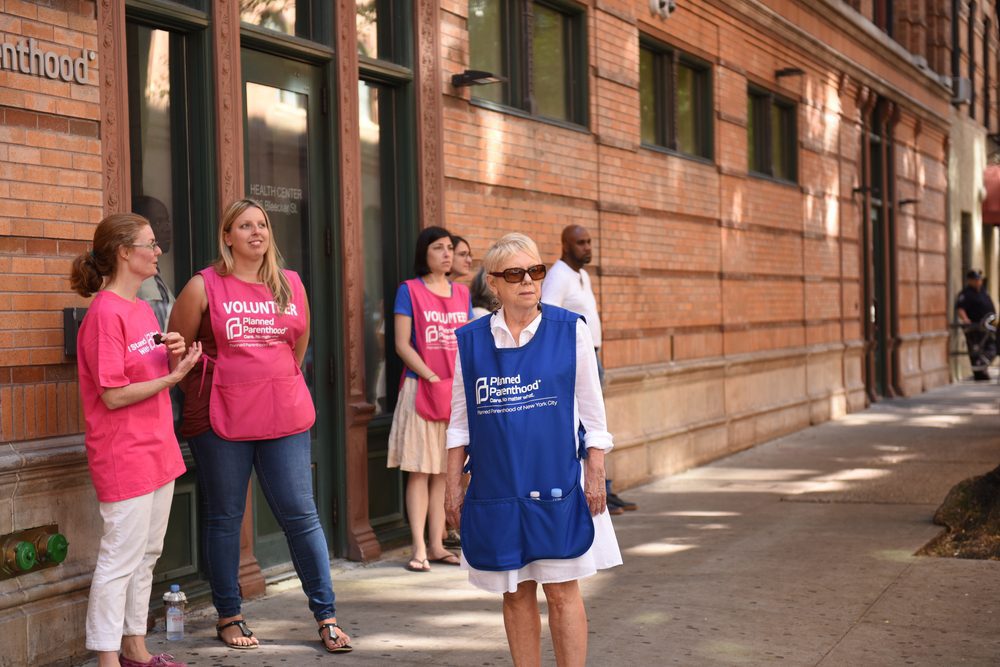
Left: Women Marching on Washington in Support of Equal Rights Amendment, Washington, D.C., USA, photographer Thomas J. O'Halloran, Warren K. Leffler, August 26, 1977. Right: People march to the U.S. Capitol Building during a Women's March rally on October 08, 2022 in Washington, DC. The march is a part of a National Weekend of Action, with movements protests held across the country to call on support for reproductive rights.
Birth control of some kind has existed for all of recorded human history, and the ability to change when and how one becomes pregnant has been a cornerstone of women’s rights.
“What [birth control] has really done is allowed women to control their destinies, and that their destiny can include being a mother and a spouse, but it doesn’t have to,” said Karen Kedrowski, a political science professor and director of the Carrie Chapman Catt Center for Women and Politics at Iowa State University.
That’s partly why limiting the birth control people can access and spreading lies about its safety are concerning: Those efforts have led to restrictive laws policing abortion, people being denied birth control, court cases, and more people choosing to drop birth control entirely.
“There’s a lot of women who’ve grown up with the expectation that they would be able to control their fertility. And now there’s a landscape of a whole bunch of different question marks,” Kedrowski said.
The evolution of women’s rights
Before birth control was widely available, many people had to use less reliable forms—barrier methods like condoms, or methods of having sex that tried to keep sperm away from a uterus.
As a result, many women’s options were limited. They couldn’t stay in school or hold a steady job if an unintended pregnancy happened. Relationships were riskier and more fraught.
That changed in a big way in the 1960s with the introduction of the birth control pill.
“It was a really important part of women leaving the private sphere as the exclusive place where they existed, particularly for white women,” said Kelly Winfrey, interim director of the Women and Gender Studies program at Iowa State University.
“If they could delay childbirth or decide how many children they wanted to have, and have a reliable way to do that…it played a really important role in the evolution of women entering the public sphere.”
‘Permission to dream’
The 1960 approval of the pill coincided with the wider Sexual Revolution, which marked an era when relationships and gender roles became freer.
“This really led to a period of sexual freedom and women being able to fully explore their sexuality without concerns about getting pregnant,” Kedrowski said.
Birth control has also allowed people to have relationships without being permanently tied to incompatible partners because of an unplanned pregnancy.
In 1965, with Griswold v Connecticut, and in 1972 with Eisenstadt v Baird, reproductive freedom expanded even more: The US Supreme Court found the Constitution ensures a right to privacy when it comes to contraceptives.
In 1973, with Roe v Wade, that right extended to abortion care.
“The decision about the right to privacy and the availability of the birth control pill coincided with a second wave of American feminism, which also gave women permission to dream,” Kedrowski said.
There were still many barriers, and the opposition to birth control and abortion had always existed alongside these bursts of progress, but Kedrowski said without reliable birth control the progress would have taken much longer.
When contraceptives were ‘obscene’
That’s a stark difference from the turn of the century.
In the earliest days of the 1910s and ’20s, Margaret Sanger was a key figure in educating people about family planning. She published an illegal pamphlet with tips and information about birth control and avoiding pregnancy. Sanger also opened a birth control clinic.
“I studied this pamphlet,” Winfrey said, “and it was so interesting because her argument really was about women being able to save their own lives (because it was so common for women to die during childbirth) and to help people who didn’t have the economic means—if you couldn’t control how many kids you had, then you couldn’t control how many mouths you had to feed.”
The pamphlet was illegal because of the 1873 Comstock Act, which defined contraceptives as “obscene” and made it a federal crime to circulate or spread contraceptives or information about them. Over time, the scope of the law was narrowed by various federal courts, and the federal government hasn’t enforced it since the 1930s.
There’s a case in front of the US Supreme Court now arguing that, because of the Comstock Act, sending abortion medication through the mail should be illegal. It’s considered a key part of the anti-abortion movement’s plans.
The ‘side effects’ argument
The first birth control pill got approval in June 1960. It had many more—and more severe—side effects than oral contraceptives do today, because it had higher levels of hormones. But many considered the trade-off to be worth it.
Today’s hormonal birth control still has some side effects. The types with estrogen rarely can cause blood clots, increase risk of stroke, and other conditions related to a small rise in blood pressure, more likely in people who are already predisposed to those complications.
Still, many social media influencers, right-wing activists like Ben Shapiro, and the anti-abortion movement have invested in an effort to use people’s bad experiences with doctors to sow misinformation and distrust of birth control.
Some doctors have said they keep that in mind when they speak to patients about birth control.
“Every time I talk to a patient, I draw a picture of their ovaries and their uterus and their fallopian tubes, and I talk about what needs to happen for a pregnancy to occur. And I talk about how birth control prevents those things from happening,” said Dr. Emily Boevers, an OB-GYN in Waverly.
Boevers also talks to patients about why they want to use birth control and for how long. Most of the people who do consultations with her are there because of painful menstrual periods.
“These are hormonal medications that actually treat a wide variety of symptoms for women,” she said. “I try to identify two or three options that I think—based on my professional opinion and what the patient has told me their goals are—might be a good fit.”
She also talks about side effects, how long they might last, and she tells patients they can switch to another method if they want.
Boevers said she doesn’t try to talk patients out of solely non-hormonal methods if their hearts are set on it, but she explained methods like period or fertility tracking only really work if a person’s period is the same every single month.
Even then, ovulation can happen at slightly different times in the cycle, which is hard to track.
Sperm can also live in the reproductive system for up to five days, “so if you ovulate at a slightly different time, or have intercourse at a slightly different time in your cycle, you could still become pregnant,” Boevers said.
Keyboard warriors
Another part of the backlash is plain misogyny in response to women working outside the home, marrying later, and having fewer, if any, children.
“There are some people who are very profoundly uncomfortable with that because it does not fit in with their views of what the proper role of men and women are in the family unit and in society,” Kedrowski explained.
Some of this anti-birth control sentiment has shown up in efforts to redefine some kinds of birth control as abortion. Another strategy is to focus on the side effects and argue birth control is dangerous for women’s health.
Winfrey said birth control should be up to each person because everyone is going to react differently or need something different.
“It really is about individual choice, and a woman or any person with a uterus working with their medical professionals to make those decisions,” she said. “I think what’s disturbing is when we have people—whether they’re legislators or other people with a microphone—who don’t have medical knowledge and just read some things on the internet trying to make decisions.”
Support Our Cause
Thank you for taking the time to read our work. Before you go, we hope you'll consider supporting our values-driven journalism, which has always strived to make clear what's really at stake for Iowans and our future.
Since day one, our goal here at Iowa Starting Line has always been to empower people across the state with fact-based news and information. We believe that when people are armed with knowledge about what's happening in their local, state, and federal governments—including who is working on their behalf and who is actively trying to block efforts aimed at improving the daily lives of Iowan families—they will be inspired to become civically engaged.


House GOP fast-tracks budget bill that would cut off Medicaid funding to Planned Parenthood
The budget package proposes steep health care cuts—and includes a new push to block patients from accessing reproductive care. In a 30-24 party-line...

Report: Majority of pregnancy-related deaths in Iowa could have been prevented
A newly released report found that 95% of pregnancy-related deaths in Iowa were preventable, and those deaths disproportionately affected women who...

Shattering stigma: Iowa woman shares her abortion story to empower others
There are different types of people who seek abortions. Here is the story of one of those women—the everyday woman who accidentally got pregnant....

New Iowa bill would ban abortion pill, sparking backlash
Republican proposes bill to effectively end 74% of abortions in Iowa by banning a pill that’s safer than penicillin and Viagra. Seventy-four...

Way more Americans are getting sterilized since Roe was struck down, research finds
A new study has found that from May to August 2022, vasectomies surged by 95% and tubal sterilizations increased by 70% among adults ages 19 to 26....

People are leaving states with abortion bans, according to study
A new analysis from the National Bureau of Economic Research found that since 2022, states with near-total abortion bans appear to have lost 36,000...





